Electronic warfare’s strategic importance has grown significantly, evident in its dedicated section in a recent essay by Gen. Valery Zaluzhny, Ukraine’s top military commander. Highlighting the “widespread use of information technology in military affairs” as crucial to breaking the war stalemate with Russia, he emphasizes its pivotal role in warfare.
The significance of these tactics extends beyond the war, turning the war into a testing ground for the United States, Europe, and China, New York Times writes.
NATO member nations have broadened initiatives to acquire and advance electronic weaponry, as stated by Thomas Withington, an expert in electronic warfare affiliated with the Royal United Services Institute, a British security think tank.
“The war in Ukraine has been the performance enhancing drug for NATO’s electromagnetic thinking,” he said. “It has been the thing that concentrates minds.”
Spoofing, a technique involving sending misleading signals, plays a crucial role in electronic warfare. This deceptive signal can mislead drones or missiles by providing false coordinates, leading them off course. Additionally, spoofers mimic the signals of missiles or planes to deceive air defense systems into detecting non-existent attacks. Another set of tools listens for radiation beams to trace their source, often employed to locate and counteract drone pilots. While the Russian military initially faced setbacks, they adapted by developing compact, mobile electronic weapons such as anti-drone guns and small jammers, creating radio-wave bubbles around trenches.
“The Russians have been more nimble at responding than we would have expected from their ground behavior,” said James A. Lewis, a former US official who writes on technology and security for the Center for Strategic and International Studies in Washington. “That should be worrisome for NATO.”
This summer, a Quantum executive and a top Ukrainian drone pilot shared insights on electronic warfare with NATO, highlighting the inadequacy of many American and European systems in the face of Ukraine’s challenges.
“We told them probably 90 percent of the American and European systems coming to Ukraine were not prepared to meet the electronic warfare challenge,” Mr. Berezhny said. “There was total understanding that something needed to change.”
Russia’s war against Ukraine marked a shift in EW, as it is the first recent war between two large and relatively advanced armies to extensively deploy and adapt electronic warfare capabilities in real time. Previously the domain of trained experts, these technologies have now reached frontline infantry troops. Ukrainian drone pilots have had to constantly adjust their methods to counter invisible attacks, experimenting with different radio frequencies and antennas to stay ahead of the evolving electronic warfare techniques.
Ukraine, facing Russia’s advanced electronic warfare capabilities, adopts a start-up strategy reminiscent of Silicon Valley. The focus is on rapid development, testing, and deployment of electronic warfare products. Ukrainian companies like Kvertus and Himera are contributing with innovations like tiny jammers and resilient $100 walkie-talkies against Russian jamming. The initiative aims to bridge the gap with Russia’s more established electronic warfare program.
Recognizing the need for change, the US, Europe, and China closely observe Ukraine’s experiences with electronic warfare against Russian systems. A Chinese report from November 2022 dissected a Russian attack that deceived NATO’s detection equipment, exposing Ukraine’s electronic defenses. As Ukraine provides a glimpse into the future of electronic battles, global powers are evaluating and adjusting their strategies accordingly.
“The Russian army’s anti-drone combat capabilities are superior to those of the US military,” the report said.
As Ukraine enhances its strategies to counter jamming, Mr. Clark from the Hudson Institute noted the sharing of these tactics with the United States and its allies. He emphasized that smaller systems are now being deployed by countries, including the United States, similar to those improvised in Ukraine. Despite advancements, some Ukrainian drone pilots express the urgency for further improvements.
Related:
- Five Ukrainian war startups taking on Russia’s brute force
- Ukraine deploys new electronic warfare systems to counter Russian airstrike tactics
- Ukraine develops new electronic warfare system to disrupt Russian drones
- Ukrainian govt expedites production of electronic warfare equipment
- Ukraine rolls out secure radio to counter Russian electronic warfare








